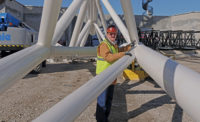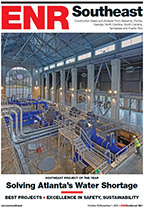If projections for the Southeast's 2014 construction market prove accurate, it's officially time for contractors and designers to forget about the gloom of the recent past and start focusing upon the coming resurgence.


That's the theme of our inaugural Watch List feature, where we highlight some of the trends, topics and projects that builders in the four-state region should keep an eye on during the coming year. Based upon the feedback of regional industry members, editorial research and data from McGraw Hill Construction about the Southeast's coming prospects, there's little doubt that 2014 should prove to be a breakout year in terms of new contract activity. And that will push the following topics to the forefront.
One driving force behind these trends is the forecast for the region in 2014—published online by ENR Southeast in November—which includes an expected 22% gain in new contracts. Or, in other words, an extra $16 billion worth of work compared with 2013.
Labor Shortage
The Great Recession decimated the construction work force, driving some to conclude that many workers have simply left the industry altogether. With that grim reality in mind, it's easy to see that staffing jobs during any future building boom could quickly become problematic.
Mark Wylie, president and CEO of the Central Florida chapter of ABC, puts it this way: "A major caution flag is the size of the construction work force, and its ability to respond to an accelerated demand for workers. Half of [Florida's] 2006 work force [has] either left the state, retired or changed careers. The lack of a work force reserve will stymie any quick expansion."
Nonresidential Revival
While residential activity has surged in recent years, contractors are likely to find themselves eyeing more nonresidential projects for future contracts in 2014, with this key sector finally pulling out of a long stall.
As ENR Southeast reported in our November outlook: "After bouncing along at an annual volume of about $19 billion for the past four years—ranging from $18.8 billion to $19.2 billion during 2010-2013—the Southeast's nonresidential market should generate nearly $24 billion in new contracts during 2014. That's enough for a 26% annual gain compared with 2013's estimate, and the highest dollar amount for this category since 2008."
Importantly, all subcategories will rebound. Commercial contracts should jump 36%, for about $10.4 billion in new work, while institutional is predicted to gain 21%, for an estimated $11.4 billion total.
Sports Construction
In early 2013, ENR Southeast noted the proliferation of plans for major sports projects across the Southeast, including a new home for the NFL's Atlanta Falcons and a rebuild of Daytona International Speedway, among others. Since then, many of these sports projects have marched down the field toward construction.
And when the Atlanta Braves made their surprise announcement to build a $672-million ballpark, along with a $400-million mixed-use development, the Southeast's sports construction market drew national attention. In addition to these projects' direct impact, the fact that these owners are building now seems to indicate an expectation of improving economic conditions overall.






Post a comment to this article
Report Abusive Comment